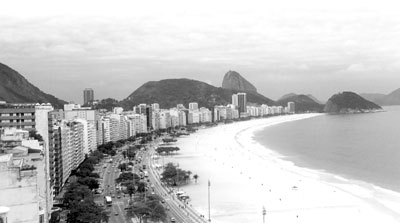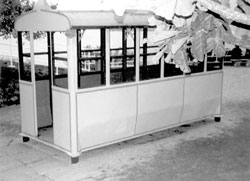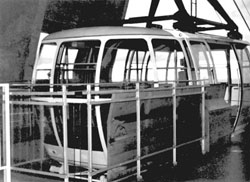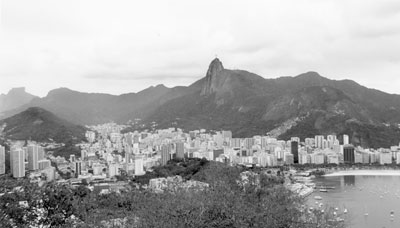Rio de Janeiro — so much more than Carnaval!
by Deanna Palic, first of four parts
Rio de Janeiro sits capriciously on a thin strip of land between the mountains and the sea. In my 40 years of visiting Rio, this astounding city has never ceased to dazzle. Rio is one of the world’s most colorful playgrounds, enhanced by its spectacular natural setting and exceptional weather year around. It’s a city with a rhythm of its own!
Nineteen glorious beaches, covering 23 miles, run through the very heart of the city and provide one of the best people-watching shows imaginable. The most famous of these beaches are Copacabana and lpanema, but there is also something to be said for Leme, Arpoador, Leblon, São Conrado and Barra de Tijuca.
Rio is a city where buildings, churches and monuments stand side by side in harmony with ultramodern, award-winning architecture. Traditional street markets have their place alongside the super-modern, air-conditioned shopping centers.
The 5,800,000 Cariocas, as Rio’s residents are fondly called, remarkably samba their way through life’s mundane activities. For the Carioca, life is one long holiday. Their being an exuberant people in love with life, the Cariocas’ joy of living is something special and contagious.
In September ’03, I returned to Rio on a press trip sponsored by the Rio Convention & Visitor’s Bureau, Varig Brasil and the Othon Palace Hotel, a first-class property facing the broad expanse of Copacabana beach.
Brazil is enjoying a grander international profile since Luiz Inacio Lula da Silva, simply known as Lula, was elected in 2003. As a result, the economy appears to be in an expansion mode. A stable currency has encouraged international hotel chains to take over some existing hotels or build completely new ones. Sofitel has taken over the former Rio Palace Hotel, and J.W. Marriott has arrived on the scene. This movement has spurred the independent hotels into renovations to ward off the competition.
Jetting there
U.S. citizens need to obtain a visa to enter Brazil. The cost of $100 for a 5-year visa reciprocates what a Brazilian citizen pays for a visa to visit our country.
Varig Brasil celebrated 75 years of service in 2002. I had the opportunity to sample their meal service in both business and economy class and, judging by today’s airline standards, Varig was far above my expectations. As part of the Star Alliance mileage program, Varig passengers can fly United Airlines out of a multitude of U.S. cities for connections to Rio de Janeiro via the Los Angeles, Miami or New York gateways. Mileage is calculated from the U.S. point of origin.
Brazil is South America’s largest country. It is as large from north to south as the United States is from east to west. The best way to visit a multitude of cities is by purchasing a Varig Brasil Air Pass. This pass, which must be purchased before arriving in Brazil, is valid for 21 days. A fare of $399 allows visits to nine cities. For reservations and additional information, call Varig Brasil at 800/468-2744.
Corcovado and Christ the Reedemer
Tijuca, the largest urban forest in the world, is watched over by the colossal statue “Christ the Redeemer,” whose open arms bless the city. Construction of the statue by the Catholic Church took five years, from 1926 to 1931. Accessibility is by cog railway, operating every 30 minutes and costing US$9.
From the top of Corcovado Mountain, 2,300 feet above the city, there is an unparalleled view of the ocean, green hills and one of the world’s most beautiful harbors. To reach the viewing platform, one must walk up 225 steps (or take the elevator). If you need to remain at the lower level, there is a restaurant with a souvenir shop.
Sugar Loaf
Equally impressive is Sugar Loaf, the loaf-shaped granite rock which guards the entrance to Guanabara Bay. Sprinkled throughout the bay are more than 100 islands, making an arrival or departure by ship a remarkable treat.
From Sugar Loaf, tour guides relate the founding of Rio de Janeiro on Jan. 1, 1502. When a Portuguese ship sailed past this impressive granite rock, the navigator noted the fast current and thought they had entered the mouth of a large river, hence the name Rio de Janeiro.
A visit timed for sunset is an unforgettable sight. As the city lights flicker on, the setting sun silhouettes Corcovado before floodlights illuminate the Christ statue for the night.
Sugar Loaf is accessible by a sequence of two bondinhos, or cable cars, at $8.50. The first stage, constructed in 1912, stops at Urca Mountain where you change to the second stage, constructed in 1913, bound for Sugar Loaf.
After our descent, we continued to marvel at the sunset from the Praia Vermelha Bar & Restaurante, at the base of Sugar Loaf, on Praia Vermelha (Red Beach). While swaying to the live music at Happy Hour, we leisurely sipped caipirinhas ($1.75) and nibbled on an assortment of appetizers. The caipirinha is a traditional drink prepared with a sugarcane liquor, cachaca, poured over chunks of crushed lime. Cachaca is also the base for the fruit juice batida, similar to a daiquiri.
Downtown Rio
Downtown, it is worthwhile to visit the Centro Cultural Banco do Brasil for its expositions and the Teatro Municipal, patterned after the Paris Opera. It is home to world-class music, dance and theater. The Art Nouveau Impressionist ceiling was painted in Paris and taken to Brazil by ship.
The National Museum of Fine Arts contains what is the most important representation of works by Brazilian artists in the country. Exhibits are arranged in chronological order so visitors can trace the developmental style of different artists as their work evolved over the years.
Another popular stop is the pyramid-style Cathedral de São Sebastião de Rio de Janeiro with 500 squares in each stunning stained-glass window.
In 1993 a project to restore parts of the downtown area was initiated. Several corridors and walking streets linking to the city’s cultural sections were upgraded. Now, al fresco coffeehouses and cafés line these streets.
The overall strategy calls for increasing the number of dwellings downtown to encourage people to live closer to their work. This has the added benefit of bringing life to downtown areas during nonworking hours. Judging from the after-hours crowds, the project appears to have been successful.
The Carmen Miranda Museum, in Flamengo Park, pays tribute to the woman known as the Brazilian Bombshell. Carmen Miranda, a vivacious, extravagantly costumed, carnival-type figure, put Copacabana and the samba on the map with her song-and-dance routines.
H. Stern jewelry
In Ipanema we took a gemological tour at the corporate headquarters of H. Stern, whose international empire of jewelry shops dazzles with Brazilian gems. Watching through windows and on special monitors, we had a bird’s-eye view of how a piece of jewelry is produced, from the cutting of the rough stone to designing, goldsmithing and gem polishing. The 12-minute tour features, in 18 languages on headsets, a taped explanation of the entire process.
Also of interest is the museum, whose permanent exhibit of magnificent rough crystals and precious stones includes the world’s largest collection of tourmalines: over 1,000 stones in a variety of colors, cuts and sizes.
The tour ends in a showroom where exquisite jewelry is on sale along with reasonably priced Brazilian handicrafts.
For anyone interested in taking the H. Stern tour, complimentary round-trip transportation is available from major hotels. Just go into the H. Stern shop in your hotel or on the street and they will give you a taxi voucher.
Girl from Ipanema
Before leaving the Ipanema area, visit the Brazilian music shop Toca do Vinicius (Rua Vinicius de Moraes 129, Rio de Janeiro, Brazil; phone 2247-5227). You can purchase books and CDs of typical music from Rio: choro, samba, bossa nova. . .
A permanent exhibition here celebrates the life of Vinicius de Moraes, a writer of poems, chronicles and plays. Vinicius became internationally famous for his composition of lyrics to the song “The Girl From Ipanema.”




